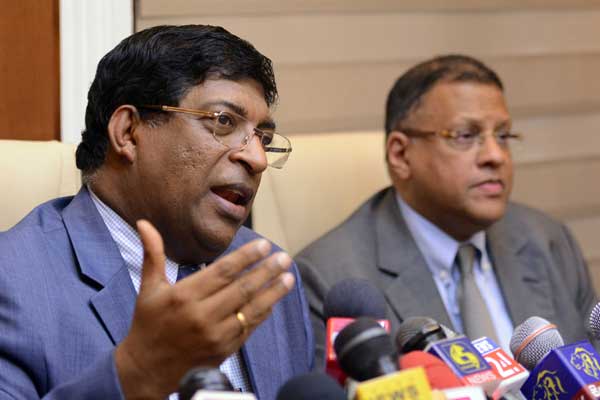01 Mar 2016 - {{hitsCtrl.values.hits}}

Fitch Ratings yesterday downgraded Sri Lanka’s sovereign credit rating to ‘B+’ from ‘BB-’ and assigned a negative outlook.
The rating action was backed by the concerns raised by Fitch in the areas of higher foreign debt, weaker revenue and decline in foreign reserves.
“The Sri Lankan sovereign faces increased refinancing risks on account of high upcoming external debt maturities. Further, the sovereign’s external liquidity position remains strained, reflecting pressure on foreign exchange reserves,” Fitch said.
In Fitch’s view, this partly reflects a weakening in policy coherence that increases the likelihood of Sri Lanka requiring external liquidity support from the International Monetary Fund (IMF) and other multilateral institutions.
Sri Lanka’s external liquidity ratio, as measured by Fitch at end-2015, was 70.9 percent, which is far below the median of ‘B’-rated peers’ of 171.9 percent and the ‘BB’ median of 152.4 percent.
As Fitch pointed out, Sri Lanka faces significant debt maturities in 2016 amid the country’s vulnerability to a shift in investor sentiment.
The rating agency estimates the sovereign’s external debt service to be close to US $ 4billion for the rest of 2016, compared with foreign reserves of US $ 6.3 billion (end-January 2016).
“Sri Lanka’s vulnerability to a shift in investor sentiment was evident when investors sold-off the equivalent of nearly US $ 2billion in local-currency government securities in 2015.
A further outflow from treasury bills and treasury bonds, which account for about 31 percent of the country’s foreign reserves, could put more pressure on reserves.”
However, Fitch believes that the prevailing low oil prices will continue to support Sri Lanka’s current-account deficit in the near term. Fitch expects the current-account deficit to remain manageable at about 3 percent of gross domestic product (GDP) over 2016-17. According to the rating agency, the deterioration in Sri Lanka’s fiscal finances is driven partly by the consistently low general government revenues.
“At an estimated 13 percent of GDP, Sri Lanka’s gross general government revenues remain far below the ‘B’ median of 25.4 percent and the ‘BB’ median of 26 percent.
The 2016 Budget did little to address this issue directly and absent any significant fiscal consolidation, Fitch expects continued fiscal slippage over 2016-17.”
Sri Lanka’s gross general government debt (GGGD) burden is estimated to have increased to more than 75 percent of GDP by end-2015, up from 71 percent at end-2014 and much higher than the ‘B’ median of 52 percent of GDP and ‘BB’ median of 43.6 percent.
Fitch has also revised downwards its forecast for foreign-exchange reserves, with reserve coverage of current external payments now forecast to decline to 2.9 months in 2016 from an estimated 3.4 months in 2015.
This forecast compares unfavourably with Fitch’s earlier forecast of 3.9 months for 2016 and is well below the ‘BB’ median of 4.2 months.
“While the authorities have undertaken certain measures to support external finances, including entering into bilateral swaps with other central banks, Fitch does not view this to be a sustainable way to improve the stability of the external finances,” the rating agency said. Fitch is also of the view that Sri Lanka’s foreign currency debt portion remains high as Sri Lanka increased its issuance of foreign-currency debt, which the rating agency estimates now makes up close to 46 percent of total public debt, up from nearly 42 percent at end-2014. “This has increased vulnerability of Sri Lanka’s public debt to a significant depreciation of the exchange rate, which would increase the debt burden in local currency terms.” On a more positive noted, Fitch noted that Sri Lanka’s macroeconomic performance remains stronger than some of its peers in the ‘B’ and ‘BB’ range with real GDP growth for the five-year period ending 2015 averaging close to 6 percent, compared with the ‘B’ median of 4.6 percent and ‘BB’ median of 3.9 percent.
Sri Lanka also continues to score highly, compared with the ‘B’ median, on basic human development indicators, such as education, health and literacy, which is indicated by its favourable ranking in the UN’s Human Development Index.
“These relative structural strengths, combined with a clean external debt service record and smooth transition of power during the presidential and parliamentary elections in 2015 indicates a basic level of political stability, which supports the rating at ‘B+’,” Fitch said.
Just one rating agency’s perception: FinMin
The Sri Lankan government presented its view on the downgrade at a media briefing which was held yesterday at the Finance Ministry.
“We ran the economy in the past. There were no credit ratings then. The economy ran well then. It runs well now,” Finance Minister Ravi Karunanayake said.
He said that the downgrade by Fitch presents no impact to Sri Lanka, as it is just the opinion of one institution.
“It’s just the perception of one institution, which is different from another. They come up with these perceptions because they want income,” Karunanayake added.
Central Bank Governor Arjuna Mahendran defended Karunanayake’s stance.
“Moody’s last week came up with a report which put us in a positive light and reduced our interest rates by 50 basis points,” he said.
He had said last week that “rating agencies like us. The IMF agreement is important because then they will bide with us as we fix our problems”.
26 Nov 2024 8 hours ago
26 Nov 2024 9 hours ago
26 Nov 2024 26 Nov 2024
26 Nov 2024 26 Nov 2024
26 Nov 2024 26 Nov 2024